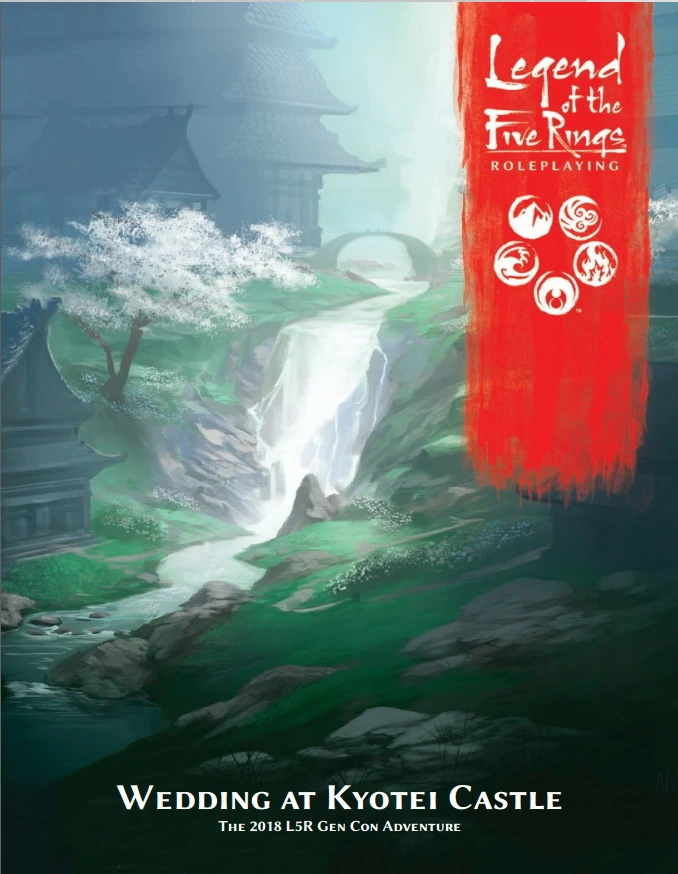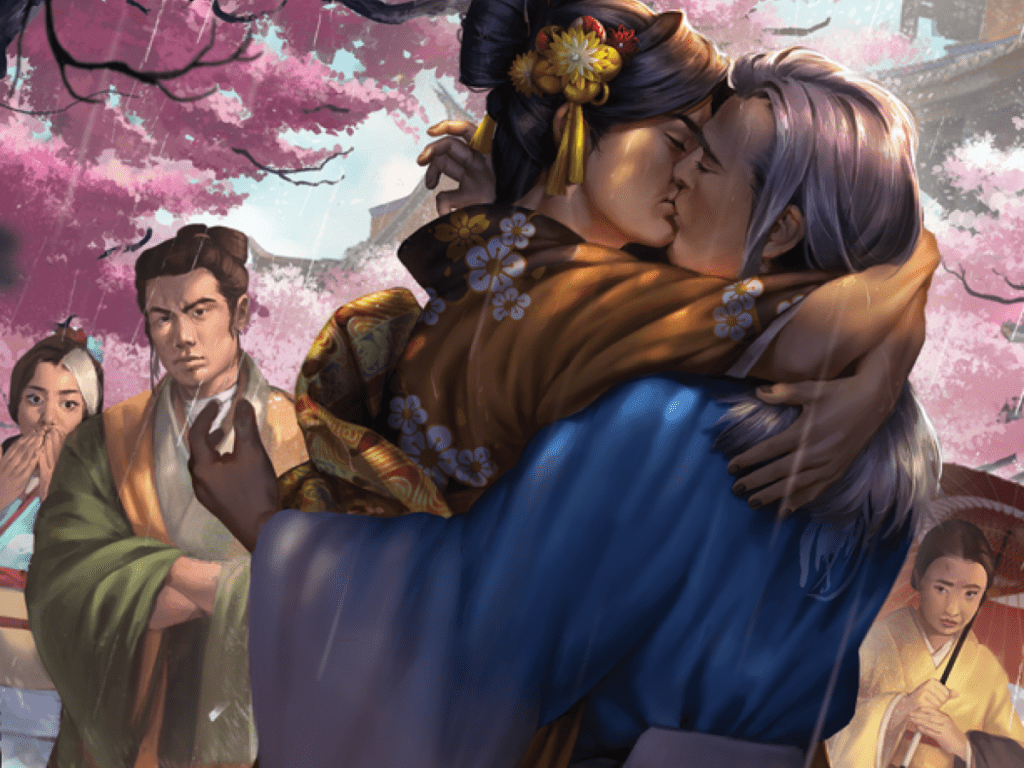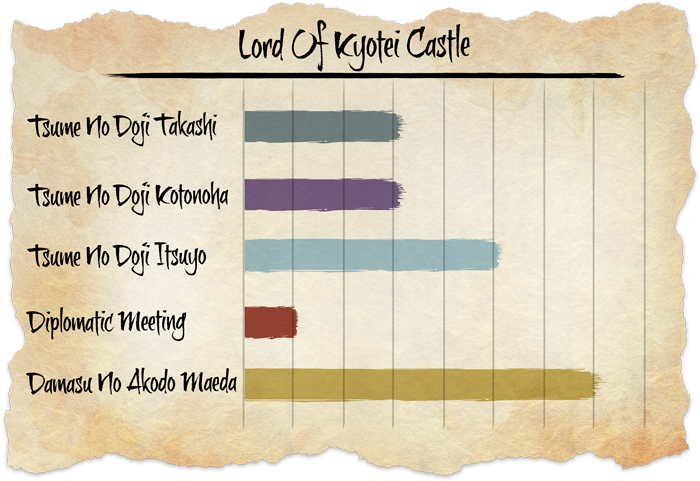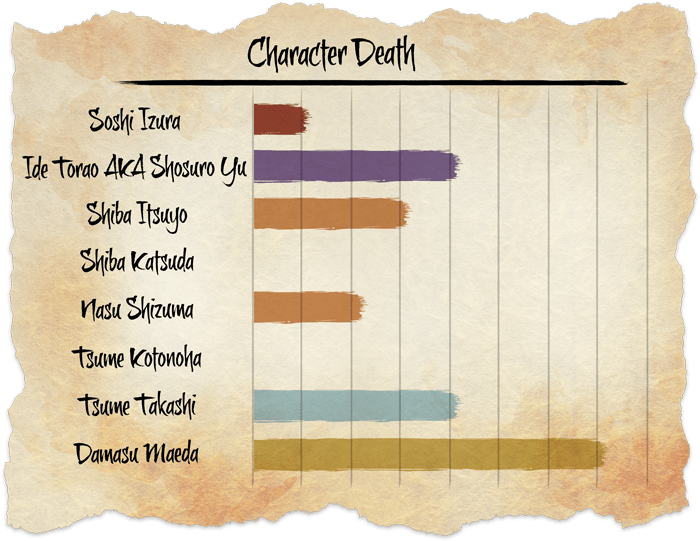The grateful peasants were falling over themselves to thank the samurai for saving them. The little girl gifted Koji with a crude-but-adorable little protective talisman that looked like a peasant girl in her finest festival clothes. The parents gifted them with some news out of the Kintani Valley: none of it good.
The valley was periodically raided by the the roving Lion troops and by the ronin hired by both sides in the conflict further north. And the local lord, the Groom in this case, Tsume no Doji Takashi wasn’t doing a particularly great job of providing security for his people. So this family was getting out before things got worse, because the next step is massacres and starvation. I’m pretty certain Ono provided them with travel papers to go to the estate in Nakamura. It isn’t strictly legal, but it might help them amid what is likely to be a flood of refugees.

Arriving at the castle, they found that Takashi may have other things on his mind.
I was going to write up in depth what happened at the Wedding at Kyotei Castle, but I think I’d rather go over what a good kind of scenario this is. Not that it is well organized or proofread as closely as it should be, but that it seems like a quintessential L5R scenario. I can see why they chose this kind of setting and event as the first of the Gencon adventures for this edition of the game. The starter box and the Topaz Championship is a good starter and great for people who’ve never played before. But if you wanted to get really into what L5R is, I think Wedding at Kyotei does a better job.

The scenario plans for there to not be just one possible outcome and what happens can be radically different – you can end up taking part in a siege, FFS – based on player input. It also allows for player PVP; yeah, sure, you all start off with the same expectations but as things progress you could play the whole thing with the safety off and let players take sides, even if that’s against other players. Those kind of sliding-door moments are entertaining as a GM because you can see all things that could have happened disappearing. I hope that players get the feeling that they are making choices that matter to the story, rather than just being the people there when the thing happens: this is more evident if the people involved are recurring characters, or a location visited more than once, so it’s up to me to tie that back in.
There’s even stuff that in the scenario that can be explored in further depth if it catches the player’s attention: the sick shrinekeeper, the dead cranes (which Doji Koji figured out), the cold case murder of Tsume Retsu, the identity of Ide Torao (which Shinjo Takuya did discover and unmask).
Having that kind of depth in a pretty short story is always great, I just think having these pivotal points written into a scenario and the branching paths that the story can take from that point on is neat. For example:
Tsume Takashi at one point asked old poetry-camp acquaintance Doji Koji for some advice via a thinly veiled pretext of finishing a poem. Takashi presented Koji with the two paths he believed he had, follow his duty or be true to his heart. Pushing him in either direction would change what happened when the shit hits the fan, but Koji did neither; reminding him that as a samurai he must walk a path without doubt, without fear and without guilt, and that he never had to choose between duty and honesty, because a right action would encompass both of those things. (Matt told me that Koji told him to quit being such a little dick, I think, so I’m Koji-ing it up). The point was, Koji deliberately didn’t help him commit, because resting your life-altering (and not just his life) decision of someone you hung around at poetry camp is⦠unseemly.
Later, as the wedding is crashed and the players must choose between aiding the last Damasu in her bid to retake the castle or siding with the (now very annoyed bride) Itsuyo in seeing this political/loveless marriage through to the end, the pendulum swung a bit as the two forces faced off at the Golden Valley Shrine. There was support for Maeda and support for Itsuyo and the outcomes are very different based on that decision.
The outcome then, of our playthrough was this: The yoriki sided with Itsuyo and the Crane/Phoenix wedding over the Lion, although it was close. The only thing everyone agreed on was that Takashi was a useless drip. The ensuing fight saw Tezuka beaten by Maeda, but not before getting in a bleeding wound that put a real time limit on Maeda’s ability to fight. With her yojimbo losing his fight against Takashi’s advisor and general, Maeda beat a retreat. She was followed by Sugi, who destroyed Maeda’s preferred ring, but the Lion destroyed the Topaz Champion’s eye in the fight among the bamboo. Takuya pursued her into the pines but found her in no state to fight. Maeda surrendered her swords and fled the field.
Takashi had finally been forced to take a side and with broken heart, selected duty. Nothing, and I mean nothing, appeals to ladies more than a weeping and begrudging groom who has to be dragged to the altar, but Itsuyo is a team player if nothing else and she saw that thing through.
Damasu-no-Akodo Maeda is wounded and at large but with no swords and no land and no family, so that’s a real grey area if she is even a Samurai at this point. Tsume-no-Doji Takashi and Shiba Itsuyo are married. The road to Toshi Ranbo is secured(ish). The Phoenix have their border security. And Sugi is 50% of the way to being the ZatÅichi character of JIM’s dreams.
Interestingly, because this was played at GenCon and Fantasy Flight were recording the results (which influenced the official storyline, albeit in a very small way) they put the results of the 20-ish sessions at that year’s GenCon:






